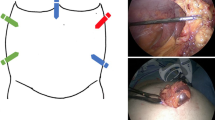Abstract
Background
Ventral hernia repair (VHR) is a commonly performed operation, but analysis of patient outcomes based upon hernia size is lacking. We sought to identify differences in operative repair and post-operative morbidity and mortality after open VHR based on hernia defect size.
Methods
Patient and operative data were retrospectively reviewed on all patients undergoing open incisional VHR between January 2008 and February 2015 by a single surgeon at the Johns Hopkins Hospital. Patient variables were described by means for continuous variables and percentages for discrete variables, with differences between groups calculated by Chi-squared analysis.
Results
During the study period, 228 patients underwent open VHR during which intraoperative defect size was measured. Patients were split into four groups based upon defect size: less than 200 cm2, 200–300 cm2, 301–400 cm2, and over 400 cm2. Patients with large defects were more likely to present with a recurrent hernia (P = 0.007) and trended towards a history of wound infections (P = 0.07). Operative time was significantly longer as defect size increased (P < 0.001). Component separation was most frequently used in patients with defects 200–300 cm2 in size (P = 0.001), in whom primary closure was most likely to occur. While mesh was used in almost all patients, the specific location (overlay only, underlay only, or overlay with underlay) depended on hernia size (P < 0.001). Mean length of stay increased with defect size (P < 0.001). Larger defect size was associated with increased 30-day morbidity (P = 0.03) but not readmission (P = 0.53), recurrence (P = 0.99), or mortality (P = 0.99).
Conclusion
Hernia defect size affects operative time and surgical technique for repair of a ventral hernia. Larger defect size is associated with increased post-operative morbidity and length of stay but not readmission, recurrence, or mortality. Hernia size greater than 400 cm2 should not be a limitation to operative repair.
Similar content being viewed by others
References
Le Huu Nho R, Mege D, Ouaissi M, Sielezneff I, Sastre B (2012) Incidence and prevention of ventral incisional hernia. J Visc Surg 149(5 Suppl):e3–e14. doi:10.1016/j.jviscsurg.2012.05.004
Mingoli A, Puggioni A, Sgarzini G, Luciani G, Corzani F, Ciccarone F, Baldassarre E, Modini C (1999) Incidence of incisional hernia following emergency abdominal surgery. Italian J Gastroenterol Hepatol 31(6):449–453
Sorensen LT, Hemmingsen UB, Kirkeby LT, Kallehave F, Jorgensen LN (2005) Smoking is a risk factor for incisional hernia. Arch Surg 140(2):119–123. doi:10.1001/archsurg.140.2.119
Yahchouchy-Chouillard E, Aura T, Picone O, Etienne JC, Fingerhut A (2003) Incisional hernias I. Related risk factors. Dig Surg 20(1):3–9
Nguyen MT, Berger RL, Hicks SC, Davila JA, Li LT, Kao LS, Liang MK (2014) Comparison of outcomes of synthetic mesh vs suture repair of elective primary ventral herniorrhaphy: a systematic review and meta-analysis. JAMA Surg 149(5):415–421. doi:10.1001/jamasurg.2013.5014
Heller L, Chike-Obi C, Xue AS (2012) Abdominal wall reconstruction with mesh and components separation. Semin Plast Surg 26(1):29–35. doi:10.1055/s-0032-1302463
Amid PK (1997) Classification of biomaterials and their related complications in abdominal wall hernia surgery. Hernia 1:15–21
Hesselink VJ, Luijendijk RW, de Wilt JH, Heide R, Jeekel J (1993) An evaluation of risk factors in incisional hernia recurrence. Surg Gynecol Obstet 176(3):228–234
Anthony T, Bergen PC, Kim LT, Henderson M, Fahey T, Rege RV, Turnage RH (2000) Factors affecting recurrence following incisional herniorrhaphy. World J Surg 24(1):95–100 (discussion 101)
Author information
Authors and Affiliations
Corresponding author
Ethics declarations
Conflict of interest
KEP declares a conflict of interest (NIH T32 Grant) indirectly related to the submitted work. NF, FA, KKB, CWH, SCA, PC, CMC, and FE are declares no conflict of interest.
Ethical approval
This study was performed with IRB approval of the institution, with a consent waver for patient involvement.
Human and animal rights
This article does not contain any studies with human participants or animals performed by any of the authors.
Informed consent
No informed consent.
Rights and permissions
About this article
Cite this article
Poruk, K.E., Farrow, N., Azar, F. et al. Effect of hernia size on operative repair and post-operative outcomes after open ventral hernia repair. Hernia 20, 805–810 (2016). https://doi.org/10.1007/s10029-016-1542-2
Received:
Accepted:
Published:
Issue Date:
DOI: https://doi.org/10.1007/s10029-016-1542-2




